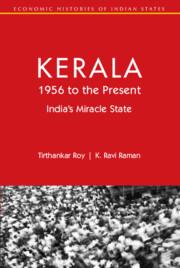Book contents
3 - The Retreat of Agriculture
Published online by Cambridge University Press: 31 May 2024
Summary
In 1956 (and even now), two distinct types of agriculture existed in the state: cultivation of seasonal field crops and cultivation of tree crops. The latter held steady in the long run. But traditional agriculture, especially paddy cultivation, for which the lowlands and the river basins were especially suitable, has seen a relentless decline since 1970. Twenty years into the new millennium, traditional agriculture was an insignificant employer and earner, and for most people still engaged in it, the land provided no more than a subsidiary income. A relative retreat from traditional agriculture is not news. It happened everywhere. In the state the fall was spectacular.
What was this a change from? Although agriculture employed a smaller proportion of the workforce than in India at the start of this journey, it was not a marginal livelihood. Land control secured the political power of the elites in the princely states. A variety of crops were cultivated throughout the state, from monsoon rice to tapioca, ginger, groundnut, sugarcane and pulses. Most were rarely traded outside the region but were vital to sustaining local consumption. Good croplands occurred in clusters. Because of the topography, land available for the cultivation of traditional field crops was less than half the total land area of the state. Alluvial soil occurs in a narrow strip along the coast or in river valleys. Land elsewhere is not as fertile, though frequently suitable for tree crops. Unlike in most regions of India, access to water was not a serious problem. Soil quality and drainage of excess water were bigger problems.
Good land, however, was extremely scarce relative to the population. The exceptionally high population density in the areas of cultivation ensured a level of available land per head that was a fraction of the Indian figure (0.6 acres against an Indian average of 3.1 acres around 1970) and low by any benchmark. Partly, the density reflected high labour demand in lowlands to deal with drainage and seasonal flooding. Paddy yield was very high in these areas, but paddy cultivation needed a lot of people. From the 1940s, this zone in the middle was emerging as a political battleground.
- Type
- Chapter
- Information
- Kerala, 1956 to the PresentIndia's Miracle State, pp. 41 - 55Publisher: Cambridge University PressPrint publication year: 2024



